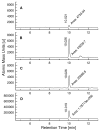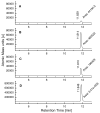Screening of protein-protein interaction modulators via sulfo-click kinetic target-guided synthesis
- PMID: 21506574
- PMCID: PMC3151735
- DOI: 10.1021/cb200085q
Screening of protein-protein interaction modulators via sulfo-click kinetic target-guided synthesis
Abstract
Kinetic target-guided synthesis (TGS) and in situ click chemistry are among unconventional discovery strategies having the potential to streamline the development of protein-protein interaction modulators (PPIMs). In kinetic TGS and in situ click chemistry, the target is directly involved in the assembly of its own potent, bidentate ligand from a pool of reactive fragments. Herein, we report the use and validation of kinetic TGS based on the sulfo-click reaction between thio acids and sulfonyl azides as a screening and synthesis platform for the identification of high-quality PPIMs. Starting from a randomly designed library consisting of 9 thio acids and 9 sulfonyl azides leading to 81 potential acylsulfonamides, the target protein, Bcl-X(L), selectively assembled four PPIMs, acylsulfonamides SZ4TA2, SZ7TA2, SZ9TA1, and SZ9TA5, which have been shown to modulate Bcl-X(L)/BH3 interactions. To further investigate the Bcl-X(L) templation effect, control experiments were carried out using two mutants of Bcl-X(L). In one mutant, phenylalanine Phe131 and aspartic acid Asp133, which are critical for the BH3 domain binding, were substituted by alanines, while arginine Arg139, a residue identified to play a crucial role in the binding of ABT-737, a BH3 mimetic, was replaced by an alanine in the other mutant. Incubation of these mutants with the reactive fragments and subsequent LC/MS-SIM analysis confirmed that these building block combinations yield the corresponding acylsulfonamides at the BH3 binding site, the actual "hot spot" of Bcl-X(L). These results validate kinetic TGS using the sulfo-click reaction as a valuable tool for the straightforward identification of high-quality PPIMs.
Figures






Similar articles
-
Structure-based redesign of the binding specificity of anti-apoptotic Bcl-x(L).J Mol Biol. 2013 Jan 9;425(1):171-85. doi: 10.1016/j.jmb.2012.11.009. Epub 2012 Nov 12. J Mol Biol. 2013. PMID: 23154169 Free PMC article.
-
The BH3 alpha-helical mimic BH3-M6 disrupts Bcl-X(L), Bcl-2, and MCL-1 protein-protein interactions with Bax, Bak, Bad, or Bim and induces apoptosis in a Bax- and Bim-dependent manner.J Biol Chem. 2011 Mar 18;286(11):9382-92. doi: 10.1074/jbc.M110.203638. Epub 2010 Dec 9. J Biol Chem. 2011. PMID: 21148306 Free PMC article.
-
In silico and in vitro elucidation of BH3 binding specificity toward Bcl-2.Biochemistry. 2012 Jul 24;51(29):5841-50. doi: 10.1021/bi3003567. Epub 2012 Jul 12. Biochemistry. 2012. PMID: 22702834 Free PMC article.
-
Kinetic target-guided synthesis.Chem Soc Rev. 2010 Apr;39(4):1316-24. doi: 10.1039/b904092g. Epub 2010 Feb 2. Chem Soc Rev. 2010. PMID: 20309488 Review.
-
BH3 mimetics: status of the field and new developments.Mol Cancer Ther. 2013 Sep;12(9):1691-700. doi: 10.1158/1535-7163.MCT-13-0058. Epub 2013 Aug 23. Mol Cancer Ther. 2013. PMID: 23974697 Review.
Cited by
-
Exploring key orientations at protein-protein interfaces with small molecule probes.J Am Chem Soc. 2013 Jan 9;135(1):167-73. doi: 10.1021/ja3067258. Epub 2012 Dec 27. J Am Chem Soc. 2013. PMID: 23270593 Free PMC article.
-
N-Acylsulfonamide: a valuable moiety to design new sulfa drug analogues.RSC Med Chem. 2023 Jul 4;14(8):1567-1571. doi: 10.1039/d3md00229b. eCollection 2023 Aug 16. RSC Med Chem. 2023. PMID: 37593573 Free PMC article.
-
Shotgun Kinetic Target-Guided Synthesis Approach Enables the Discovery of Small-Molecule Inhibitors against Pathogenic Free-Living Amoeba Glucokinases.ACS Infect Dis. 2023 Nov 10;9(11):2190-2201. doi: 10.1021/acsinfecdis.3c00284. Epub 2023 Oct 11. ACS Infect Dis. 2023. PMID: 37820055 Free PMC article.
-
Proteintemplat-gesteuerte Fragmentligationen - von der molekularen Erkennung zur Wirkstofffindung.Angew Chem Weinheim Bergstr Ger. 2017 Jun 19;129(26):7464-7485. doi: 10.1002/ange.201610372. Epub 2017 May 31. Angew Chem Weinheim Bergstr Ger. 2017. PMID: 32313319 Free PMC article.
-
Probing the binding site of abl tyrosine kinase using in situ click chemistry.ACS Med Chem Lett. 2013 Jan 15;4(2):274-7. doi: 10.1021/ml300394w. eCollection 2013 Feb 14. ACS Med Chem Lett. 2013. PMID: 24900659 Free PMC article.
References
-
- Wells JA, McClendon CL. Reaching for high-hanging fruit in drug discovery at protein-protein interfaces. Nature (London, United Kingdom) 2007;450:1001–1009. - PubMed
-
- Arkin M. Protein-protein interactions and cancer: small molecules going in for the kill. Current Opinion in Chemical Biology. 2005;9:317–324. - PubMed
-
- Arkin MR, Wells JA. Small-molecule inhibitors of protein-protein interactions: Progressing towards the dream. Nature Reviews Drug Discovery. 2004;3:301–317. - PubMed
-
- Berg T. Modulation of protein-protein interactions with small organic molecules. Angewandte Chemie-International Edition. 2003;42:2462–2481. - PubMed
-
- Preissner R, Goede A, Frommel C. Dictionary of interfaces in proteins (DIP). Data bank of complementary molecular surface patches. Journal of Molecular Biology. 1998;280:535–550. - PubMed
Publication types
MeSH terms
Substances
Grants and funding
LinkOut - more resources
Full Text Sources
Other Literature Sources
Research Materials

